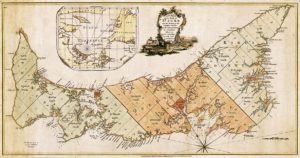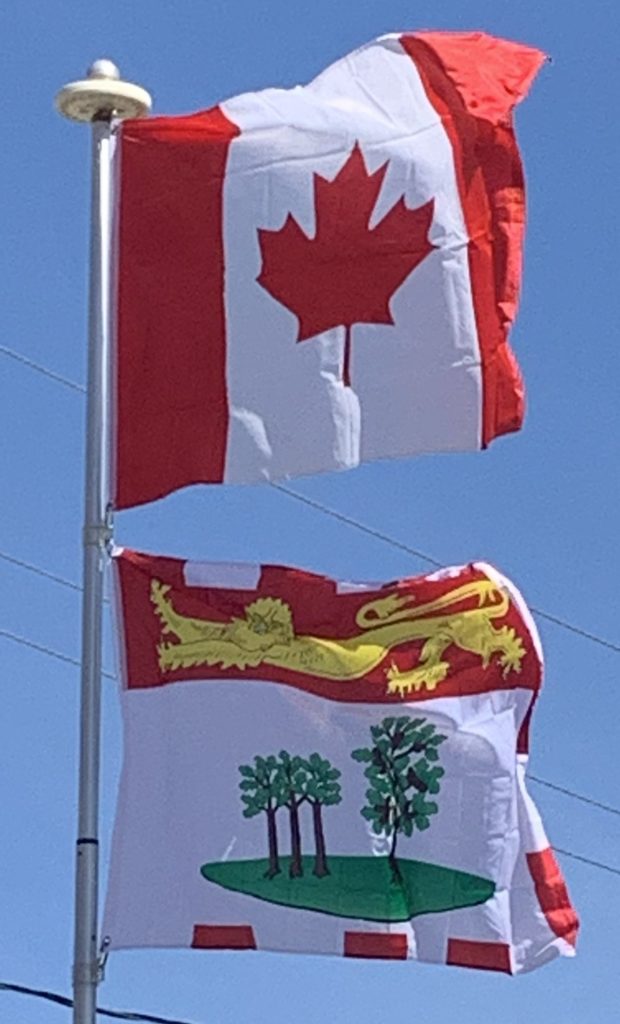During the American Revolutionary War Charlottetown was raided in 1775 by a pair of American-employed privateers. Two armed schooners, Franklin and Hancock, from Beverly, Massachusetts, made prisoner of the attorney-general at Charlottetown, on advice given them by some Pictou residents after they had taken eight fishing vessels in the Straight of Canso.

During and after the American Revolutionary War, from 1776 to 1783, the colony’s efforts to attract exiled Loyalist refugees from the rebellious American colonies met with some success. Walter Patterson’s brother, John Patterson, one of the original grantees of land on the island, was a temporarily exiled Loyalist and led efforts to persuade others to come. Governor Patterson dismissal in 1787, and his recall to London in 1789 dampened his brother’s efforts, leading John to focus on his interests in the United States. Edmund Fanning, also a Loyalist exiled by the Revolution, took over as the second governor, serving until 1804. His tenure was more successful than Patterson’s. A high influx of Scottish Highlanders in the late 1700s also resulted in St. John’s Island having the highest proportion of Scottish immigrants in Canada. This led to a higher proportion of Scottish Gaelic speakers and thriving culture surviving on the island than in Scotland itself, as the settlers could more easily avoid English influence overseas.
On 29 November 1798, during Fanning’s administration, the British government granted approval to change the colony’s name from St. John’s Island to Prince Edward Island to distinguish it from areas with similar names in what is now Atlantic Canada, such as the cities of Saint John in New Brunswick and St. John’s in Newfoundland. The colony’s new name honoured the fourth son of King George III, Prince Edward Augustus, the Duke of Kent (1767–1820), who subsequently led the British military forces on the continent as Commander-in-Chief, North America (1799–1800), with his headquarters in Halifax.
In 1853, the Island government passed the Land Purchase Act which empowered them to purchase lands from those owners who were willing to sell, and then resell the land to settlers for low prices. This scheme collapsed when the Island ran short of money to continue with the purchases. Many of these lands also were fertile, and were some of the key factors to sustaining Prince Edward Island’s economy.
Confederation:
In September 1864, Prince Edward Island hosted the Charlottetown Conference, which was the first meeting in the process leading to the Quebec Resolutions and the creation of Canada in 1867. Prince Edward Island did not find the terms of union favorable and balked at joining in 1867, choosing to remain a colony of the United Kingdom. In the late 1860s, the colony examined various options, including the possibility of becoming a discrete dominion unto itself, as well as entertaining delegations from the United States, who were interested in Prince Edward Island joining the United States.
In 1871, the colony began construction of a railway and, frustrated by Great Britain’s Colonial Office, began negotiations with the United States. In 1873, Canadian Prime Minister Sir John A. Macdonald, anxious to thwart American expansionism and facing the distraction of the Pacific Scandal, negotiated for Prince Edward Island to join Canada. The Dominion Government of Canada assumed the colony’s extensive railway debts and agreed to finance a buy-out of the last of the colony’s absentee landlords to free the island of leasehold tenure and from any new immigrants entering the island (accomplished through the passage of the Land Purchase Act, 1875). Prince Edward Island entered Confederation on July 1, 1873.
